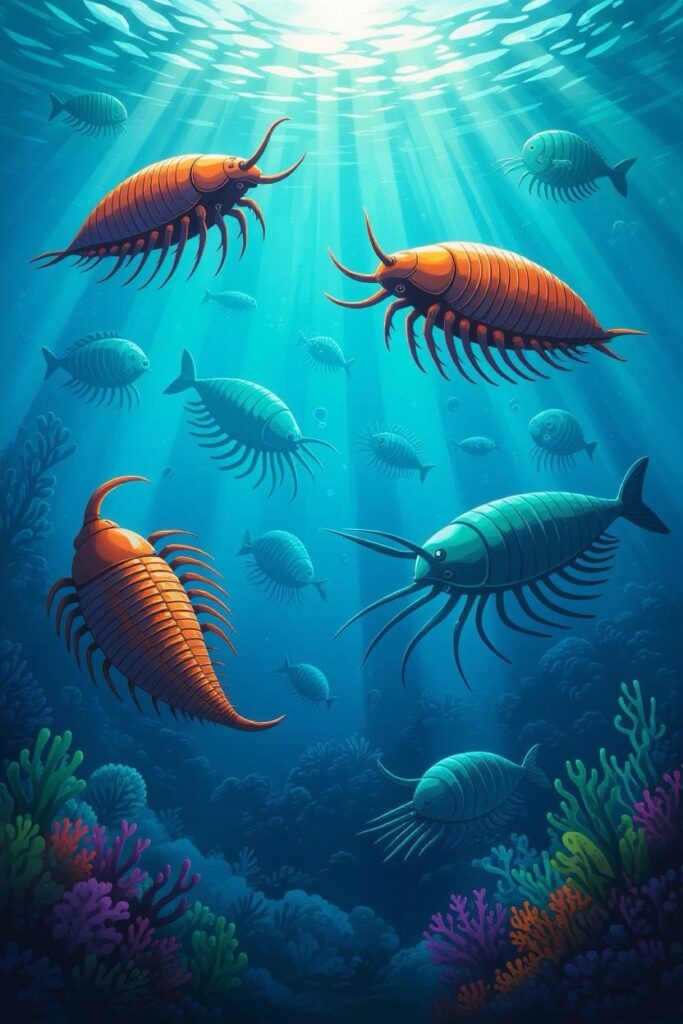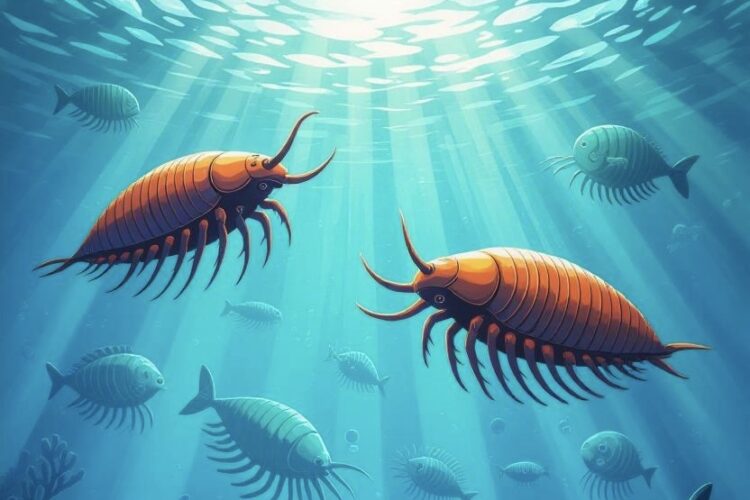Before dinosaurs, Earth’s life evolved over billions of years, starting in the Precambrian with simple bacteria and stromatolites, followed by soft-bodied Ediacaran biota. The Cambrian Explosion brought diverse marine life like trilobites and Anomalocaris, with early vertebrates like Haikouichthys. The Ordovician saw brachiopods and ammonites thrive until a mass extinction hit. In the Silurian, plants and arthropods colonized land, while jawed fish evolved. The Devonian, the “Age of Fishes,” introduced tetrapods like Ichthyostega. Carboniferous swamps hosted giant insects and amphibians, with amniotic eggs appearing. The Permian featured synapsids like Dimetrodon and ended with a catastrophic extinction, paving the way for dinosaurs. Fossils reveal how lungs and amniotic eggs drove evolution, showing life’s resilience through mass extinctions.
Long Version
Life on Earth Before Dinosaurs: From Primordial Origins to the Dawn of the Mesozoic
The story of prehistoric life on ancient Earth unfolds across vast stretches of the geological timeline, long before dinosaurs roamed the planet. Spanning the Precambrian supereon and the Paleozoic Era, this period witnessed the emergence of primitive organisms, explosive biodiversity, and pivotal evolutionary innovations that shaped all subsequent life. Fossils preserved in rock layers reveal a world dominated first by marine life, then by pioneering land colonization, culminating in complex vertebrates and invertebrates. Understanding these eras provides profound insights into evolution, extinction events, and the resilience of life amid dramatic environmental shifts.
The Precambrian: Foundations of Life in a Hostile World
The Precambrian encompasses roughly 88% of Earth’s history, from about 4.6 billion years ago to 541 million years ago, divided into the Hadean Eon, Archean Eon, and Proterozoic Eon. During the Hadean Eon, ancient Earth was a molten inferno with intense volcanic activity and no oxygen-rich atmosphere, making it inhospitable for life. As the planet cooled, primitive organisms—simple, single-celled bacteria—emerged around 3.5 billion years ago, evidenced by microfossils resembling algae and stromatolites, layered structures built by cyanobacteria that oxygenated the oceans.
By the late Precambrian, in the Ediacaran period, soft-bodied Ediacaran biota appeared, representing some of the earliest multicellular life forms. These enigmatic, disk-like and frond-shaped invertebrates inhabited shallow seas, marking early evolutionary innovations in body plans. Stromatolites continued to thrive, but the stage was set for greater complexity as oxygen levels rose, paving the way for more advanced marine life.
The Cambrian Explosion: A Burst of Marine Biodiversity
The transition to the Paleozoic Era began with the Cambrian Explosion around 538.8 million years ago, a rapid diversification of life that introduced hard-shelled invertebrates and early vertebrates. This event, lasting perhaps as little as 20 million years, transformed ancient Earth’s oceans into teeming ecosystems. Trilobites, armored arthropods with segmented bodies, dominated the seafloor, while predators like Anomalocaris—shrimp-like giants with grasping appendages—hunted amid primitive organisms.
Early chordates such as Haikouichthys, a fish-like creature with a notochord, hinted at the evolution of vertebrates. Fossils from sites like the Burgess Shale reveal extraordinary biodiversity, including sponges, worms, and other invertebrates that experimented with novel body structures. This explosion of marine life set evolutionary patterns that influenced all future phyla.
Ordovician: Expansion and the First Mass Extinction
Following the Cambrian, the Ordovician period (485-443 million years ago) saw continued growth in marine biodiversity. Brachiopods, bivalve-like filter feeders, proliferated alongside crinoids—sea lilies attached to the seafloor—and ammonites, coiled cephalopods that became adept swimmers. Arthropods diversified further, and early vertebrates like jawless fish patrolled the waters.
Simple plants began tentative land colonization, but life remained predominantly aquatic. The period ended with a mass extinction, likely triggered by glaciation and falling sea levels, wiping out up to 85% of species and reshaping ecosystems. This event underscored the vulnerability of prehistoric life to environmental changes.
Silurian: Bridging Sea and Land
The Silurian (443-419 million years ago) marked a recovery from extinction, with rebounding marine life and the first significant land colonization. Vascular plants spread across damp terrains, while arthropods like millipedes and scorpions ventured ashore, adapting lungs for terrestrial breathing. In the seas, jawed fish evolved, enhancing predation and evolutionary innovations.
Coral reefs flourished, supporting diverse invertebrates. This era’s fossils illustrate a pivotal shift, as life transitioned from exclusively marine to amphibious forms, setting the stage for greater terrestrial biodiversity.
Devonian: The Age of Fishes and Tetrapod Emergence
Known as the “Age of Fishes,” the Devonian (419-358 million years ago) featured explosive evolution in aquatic vertebrates. Lobe-finned fish developed sturdy limbs, leading to tetrapods—four-limbed creatures that could haul themselves onto land. Early amphibians, such as Ichthyostega, possessed lungs and limbs, enabling brief forays from water.
Forests of primitive ferns and trees expanded land colonization, while marine life included armored placoderms and diverse invertebrates. A late Devonian extinction event, possibly from anoxia or asteroid impacts, reduced biodiversity but spurred adaptations in survivors.
Carboniferous: Swamps, Giant Insects, and Amphibian Dominance
The Carboniferous (358-299 million years ago) transformed ancient Earth with vast swamp forests that later formed coal deposits. High oxygen levels allowed giant insects, such as dragonflies with two-foot wingspans, to thrive among arthropods. Amphibians, now fully terrestrial in some cases, dominated as predators and herbivores.
Evolutionary innovations included the amniotic egg in early reptile-like animals, providing independence from water for reproduction. Marine life persisted with crinoids and brachiopods, but the era’s lush environments boosted overall biodiversity before a minor extinction event.
Permian: Rise of Synapsids and the Supercontinent
In the Permian (299-252 million years ago), the supercontinent Pangaea formed, altering climates and ecosystems. Synapsids, mammal-like reptiles including pelycosaurs with sail-backed Dimetrodon, evolved alongside gorgonopsids—saber-toothed predators that hunted with ferocious efficiency. Archosaurs, ancestors to dinosaurs, appeared late in the era.
Reptile-like animals with amniotic eggs gained advantages in arid interiors, while amphibians declined. Marine biodiversity included ammonites and crinoids, but the period ended with the Permian-Triassic extinction—the most devastating mass extinction, eradicating 96% of marine species and 70% of terrestrial vertebrates due to volcanism, ocean acidification, and climate upheaval.
Legacy of Pre-Dinosaur Life: Insights from Fossils and Evolution
The extinction events that punctuated this geological timeline, from Ordovician glaciation to the cataclysmic Permian-Triassic, highlight life’s adaptability. Fossils offer windows into these worlds, revealing how invertebrates like trilobites and brachiopods gave way to vertebrates, and how land colonization by tetrapods and arthropods enabled complex ecosystems. Evolutionary innovations—lungs for breathing air, amniotic eggs for terrestrial reproduction—laid the groundwork for post-extinction recovery.
This era’s narrative underscores that biodiversity thrives amid change, but mass extinctions reset the board, allowing new forms like dinosaurs to emerge. By studying these ancient patterns, we gain valuable perspectives on current environmental challenges and the enduring thread of evolution on Earth.

Hashtags For Social Media
#PrehistoricLife #AncientEarth #BeforeDinosaurs #PaleozoicEra #CambrianExplosion #FossilHunters #EvolutionStory #MarineMysteries #LandColonization #Trilobites #Anomalocaris #EdiacaranBiota #Stromatolites #MassExtinction #PermianTriassic #Synapsids #Gorgonopsid #Tetrapods #AmnioticEggs #GiantInsects #CarboniferousSwamps #DevonianFishes #SilurianPlants #OrdovicianOceans #PrecambrianWorld #EarthHistory #Paleontology #AncientCreatures #PreDinosaurEra #ScienceFacts
Related Questions, Words, Phrases
what was life like before dinosaurs | prehistoric animals before dinosaurs | evolution of life pre-dinosaurs | ancient earth creatures before dinos | timeline of life on earth before dinosaurs | what existed before dinosaurs | precambrian life forms | cambrian explosion explained | paleozoic era animals | life before the mesozoic era | early vertebrates before dinosaurs | marine life in ancient oceans pre-dinosaurs | land colonization by early organisms | fossils from before dinosaurs | mass extinctions before dinosaurs | permian-triassic extinction event | synapsids and pelycosaurs | gorgonopsid predators | ediacaran biota mysteries | stromatolites and early bacteria | devonian age of fishes | carboniferous giant insects | silurian land plants | ordovician marine biodiversity | tetrapods emergence before dinosaurs | amniotic eggs evolution | archosaurs ancestors | supercontinent pangaea formation | haikouichthys early chordate | anomalocaris cambrian predator | trilobites dominance in paleozoic | brachiopods and ammonites | crinoids sea lilies | reptile-like animals pre-dinosaurs | biodiversity before dinosaur era






